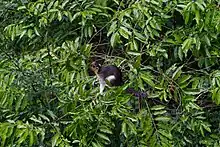Cream-coloured giant squirrel
The cream-coloured giant squirrel or pale giant squirrel (Ratufa affinis) is a large tree squirrel in the genus Ratufa found in forests in the Thai-Malay Peninsula, Sumatra (Indonesia), Borneo (Brunei, Indonesia and Malaysia) and nearby small islands. There have been no sightings in Singapore since 1995[3][2] and it is believed to be extinct.[1] Reported sightings in Vietnam in 1984 are considered to be dubious.
| Cream-coloured giant squirrel | |
|---|---|
 | |
 | |
| From Sepilok, Sabah, Malaysia. Bornean populations, as the one shown, often are much darker than those elsewhere | |
| Scientific classification | |
| Kingdom: | Animalia |
| Phylum: | Chordata |
| Class: | Mammalia |
| Order: | Rodentia |
| Family: | Sciuridae |
| Genus: | Ratufa |
| Species: | R. affinis |
| Binomial name | |
| Ratufa affinis (Raffles, 1821) | |
| Subspecies[2] | |
| |
 | |
| Cream-coloured giant squirrel range | |
Description
The cream-coloured giant squirrel is one of the largest squirrels. It has a head–and–body length of 31–38 cm (1 ft 0 in–1 ft 3 in), a tail length of 37–44 cm (1 ft 3 in–1 ft 5 in) and weighs 875–1,500 g (1.929–3.307 lb).[4][5] On average, adults of both sexes have a head–and–body length of about 34 cm (1 ft 1 in) and tail length of 42 cm (1 ft 5 in), while females weight about 1,250 g (2.76 lb) and males 1,050 g (2.31 lb).[6]
As suggested by its name, the cream-coloured giant squirrel is typically overall cream to very light orangish-brown, while the underparts are whitish-cream.[4][6] In Borneo and nearby small islands where it is the only Ratufa giant squirrel, some populations resemble cream-coloured giant squirrels from elsewhere, but most have upperparts that are medium-dark grey, sometimes almost black (contrasting strongly with the whitish-cream underparts), the flanks and thighs can have a reddish-buff tinge and the cheeks are orangish.[5][6]
Habitat
The cream-coloured giant squirrel makes its home in lower montane and secondary forests, frequenting dipterocarp trees. It rarely enters plantations or settlements, preferring the forest. Although this squirrel primarily inhabits the upper canopy of the forest, it will at times come to ground in order to hunt smaller species of squirrels, or to cross gaps in the trees.
Behaviour
This species is diurnal, active during morning and evening. They live either in pairs or alone. When it is angry or shocked, it will give a loud sound that can be heard from afar.
Although this squirrel often will make holes in trees for shelter, during the breeding season it constructs a large globular drey (or nest) in tree branches, roughly the size of an eagle’s aerie. The young are born and raised in this nest.
The main dietary habits of Ratufa affinis are seeds, which it supplements with leaves, fruits, nuts, bark, insects, and eggs. The squirrel has a very short thumb that it uses to hold and control its food while feeding.
Unlike other tree squirrels, the cream-coloured giant squirrel does not sit upright with its tail arched over its back while feeding; instead, it balances itself with its hind feet on a branch so that its hands are free to control its food. In this position the axis of the squirrels body is held at right angles to the support, with its head and forequarters on one side of the branch, and the tail as a counterweight on the other side.
Taxonomy
The table below lists the nine recognized subspecies of Ratufa affinis, along with any synonyms associated with each subspecies:[2]
| Subspecies | Authority | Synonyms |
|---|---|---|
| R. a. affinis | Raffles (1821) | albiceps, aureiventer, frontalis, interposita, johorensis, klossi, pyrsonota |
| R. a. bancana | Lyon (1906) | none |
| R. a. baramensis | Bonhote (1900) | banguei, dulitensis, lumholtzi, sandakanensis |
| R. a. bunguranensis | Thomas and Hartert (1894) | confinis, nanogigas, notabilis, sirhassenensis |
| R. a. cothurnata | Lyon (1911) | griseicollis |
| R. a. ephippium | Müller (1838) | vittata, vittatula |
| R. a. hypoleucos | Horsfield (1823) | arusinus, balae, catemana, femoralis, masae, nigrescens, piniensis |
| R. a. insignis | Miller (1903) | bulana, carimonensis, condurensis, conspicua |
| R. a. polia | Lyon (1906) | none |
References
- Duckworth, J. W.; Meijaard, E.; Giman, B. & Han, K. H. (2008). "Ratufa affinis". IUCN Red List of Threatened Species. 2008. Retrieved 6 January 2009.CS1 maint: ref=harv (link)
- Thorington, R.W., Jr.; Hoffman, R.S. (2005). "Family Sciuridae". In Wilson, D.E.; Reeder, D.M (eds.). Mammal Species of the World: A Taxonomic and Geographic Reference (3rd ed.). Johns Hopkins University Press. p. 754. ISBN 978-0-8018-8221-0. OCLC 62265494.
- Singapore biodiversity : an encyclopedia of the natural environment and sustainable development. Ng, Peter K. L., Corlett, Richard., Tan, Hugh T. W., Raffles Museum of Biodiversity Research. Singapore: Editions Didier Millet in association with Raffles Museum of Biodiversity Research. 2011. ISBN 978-981-4260-08-4. OCLC 719429723.CS1 maint: others (link)
- Francis, C.M. (2008). A Guide to the Mammals of Southeast Asia. Princeton University Press. pp. 140–141, 330. ISBN 978-0-691-13551-9.
- Payne, J.; C.F. Francis (1998). A Field Guide to the Mammals of Borneo (3 ed.). The Sabah Society. pp. 80–81, 233–234. ISBN 967-99947-1-6.
- Thorington Jr., R.W.; J.L. Koprowski; M.A. Steele; J.F. Whatton (2012). Squirrels of the World. Baltimore: Johns Hopkins University Press. pp. 23–24. ISBN 978-1-4214-0469-1.
Bibliography
- Nowak, Ronald M. Walker’s mammals of the world. Baltimore: Johns Hopkins University Press, 1999. ISBN 978-0-8018-5789-8, OCLC: 39045218. Chapter: "Sciuridae: squirrels, chipmunks, marmots, and prairie dogs" in volume two.
External links
- Pale giant squirrel (Ratufa affinis) - Arkive.org page about this species, includes images.
